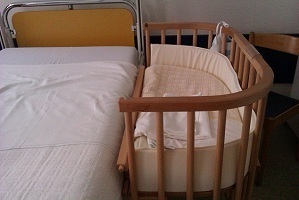Side-Car Cribs & Bedside Cots
Side-Car Cribs & Bedside Cots
Within many UK hospitals standard practice is for infants to room-in with their mothers. In most cases, infants are placed to sleep in standard cots (four-sided, standalone, bassinettes). Some hospitals now provide mothers with a side-car crib (a three-sided bassinette that securely attaches onto the side of the mothers’ bed) for infants to sleep in while on the postnatal ward. This allows mother-infant dyads easier access to each other, whilst still providing separate surfaces for sleep. In recent years researchers have evaluated the benefits of using side-car cribs on postnatal wards, however similar research is yet to be done to investigate the use of similar cribs in the home environment.
Breastfeeding
Several research studies have investigated the impact of infant sleep location on the postnatal ward (standard cot versus side-car crib) on breastfeeding outcomes. To date, research has found that following an unassisted, unmedicated vaginal delivery, infants assigned a side-car crib breastfed significantly more frequently whilst on the postnatal ward, and breastfed for longer after leaving hospital, compared to infants who were assigned a standard cot (Ball et al. 2006; Ball 2008; Robinson 2014). These results have not, however, been replicated following deliveries where mothers received opioid labour analgesia or obstetric intervention (i.e. instrumental delivery and/or caesarean section delivery) (Ball et al. 2011; Tully and Ball 2012). The World Health Organisation (2009) recommend having one’s infant easily accessible postpartum. This is supported by Tully et al. (2014), adding that this is not successfully accomplished in stand-alone cots, suggesting side-car cribs as the optimal strategy.
Infant safety
No studies have found any evidence that side-car cots pose any risk to babies. One study (Tully and Ball 2012) suggested that following a caesarean section delivery, the height and angle of a standard cot posed several potential risks to infants whose mother’s movements were impaired as a result of the caesarean section procedure. The observed risks associated with the standard cot after caesarean section delivery included mothers lifting the infant without supporting their head, tipping the cot whist attempting to place the infant within it, dropping the infant into the cot and prone infant sleep. A recent American Academy of Pediatrics report on Safe Sleep and Skin to Skin Contact in the Neonatal Period highlighted the potential of side-car cribs for enhancing infant safety on the partnatal unit (Feldman-Winter et al 2016).
Thompson and Moon (2016) investigated the dangers and injuries obtained by infants using at-home co-sleepers. They concluded that when used appropriately they are just as safe or safer than any other type of cot/crib and accidents remain very low overall.
Staff contact
In two studies, demands on staff time have been assessed according to cot type. In the first (Ball et al. 2006), mothers who experienced an unassisted, unmedicated vaginal delivery and were allocated a side-car crib called postnatal ward staff significantly more frequently than mothers allocated a standard cot. There was no difference in the duration of visits to mothers made by staff. In contrast, caesarean section mothers (Tully and Ball 2012) stated that they felt the side-car crib minimised calls to postnatal ward staff. Tully and Ball reported that staff spent significantly less time with mother-infant dyads allocated a side-car crib compared to the standard cot.
Maternal perceptions
Regardless of mode of delivery, mothers have expressed an overwhelming enthusiasm and preference for side-car cribs whilst on the postnatal ward (Tully and Ball 2012; Tully et al., 2014). Mothers stated that side-car cribs, unlike standard cots, permitted visual and physical access to their infants; enabled emotional closeness; facilitated breastfeeding; allowed them to settle their infant quickly; and minimised calls to postnatal ward staff.
Following a caesarean section, mothers commented unfavourably about standard cots compared to side-car crib use (Tully and Ball 2012; Tully et al., 2014). Furthermore, side-car cribs can play an important role in promoting mother-infant contact and successful breastfeeding initiation amongst these dyads (Tully et al., 2014). This is significant, as this method of non-labour induced delivery tends to result in lower rates of breastfeeding overall due to inhibited lactation and physical pain.
Similar findings were reported following an audit of different cot-types trialled on Belgian postnatal wards which led to some hospitals adopting a practice of exclusively using side-car cribs on the post-natal ward (wooden variety, see picture below right, which are different in design to those commonly used in UK). (Martine van Haver, Midwife, Lueven, pers comm 2012).
UK side-car

Belgian BabyBay

